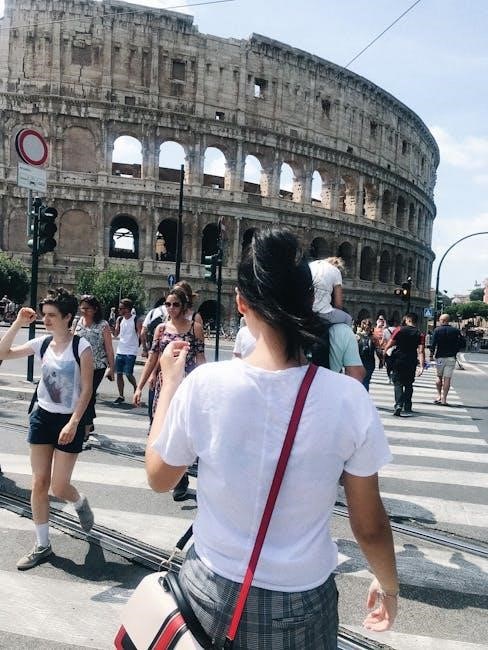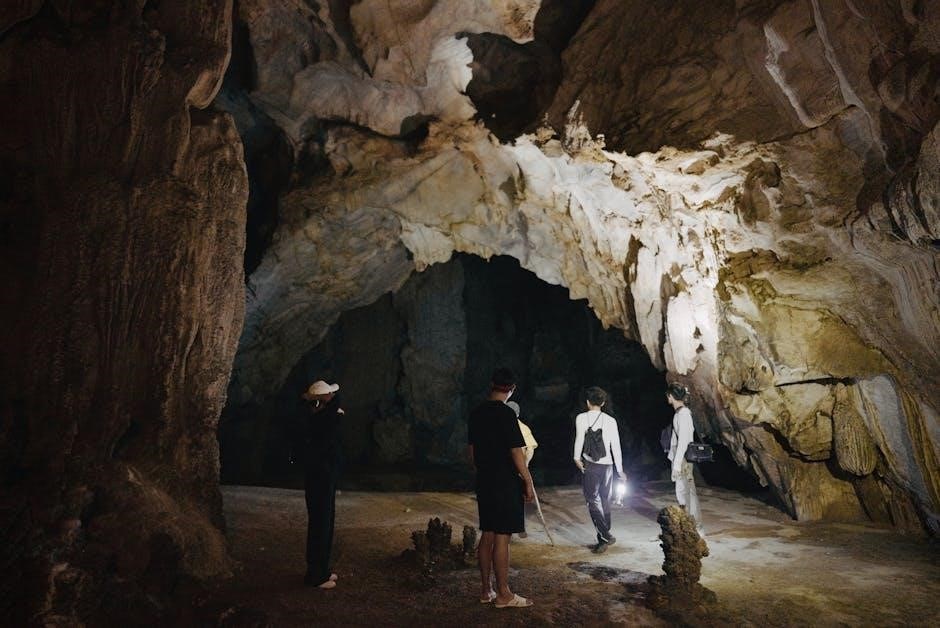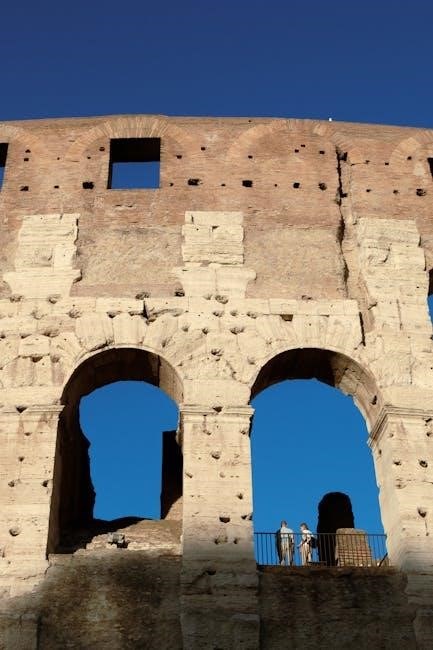A self-guided Colosseum tour offers flexibility and a personalized experience, allowing you to explore at your own pace, avoid crowds, and create a memorable visit tailored to your interests․
Overview of the Colosseum
The Colosseum, one of Rome’s most iconic landmarks, is an ancient amphitheater that stands as a testament to the city’s rich history․ Built in the 1st century AD, it was the largest amphitheater in the Roman Empire, capable of holding up to 80,000 spectators․ This architectural marvel hosted gladiatorial contests, animal hunts, and public spectacles, serving as a symbol of Roman power and engineering prowess․ The Colosseum’s design, with its elliptical shape and tiered seating, allowed for efficient crowd management and optimal visibility for all attendees․ Today, it is a UNESCO World Heritage Site and a must-visit attraction for anyone exploring Rome․ Visitors can marvel at the ancient structure’s grandeur and gain insights into its historical significance through guided or self-guided tours․ The Colosseum’s enduring presence continues to captivate millions annually, making it a cornerstone of Rome’s cultural and historical identity․
Why Choose a Self-Guided Tour?
A self-guided tour of the Colosseum offers unparalleled flexibility and personalization, allowing visitors to explore at their own pace․ Unlike guided tours, which often follow a set itinerary and timeline, self-guided tours enable you to linger at areas of interest or skip sections that don’t captivate you․ This approach is ideal for independent travelers who prefer autonomy and the freedom to create their own experience․ With the help of audio guides, apps, and informational resources, you can delve into the Colosseum’s history without the constraints of a group; Additionally, self-guided tours are generally more budget-friendly, as they eliminate the cost of a professional guide․ This method also allows for a more immersive and introspective experience, letting you connect with the ancient structure on your own terms․ By choosing a self-guided tour, you can tailor your visit to suit your interests and preferences perfectly․
Benefits of a Flexible Itinerary
A flexible itinerary is one of the most significant advantages of a self-guided Colosseum tour․ It allows visitors to explore the ancient amphitheater and its surroundings at their own pace, spending more time on areas that spark curiosity and less on those that don’t․ This flexibility is particularly beneficial for travelers with varying interests or families with children, as it accommodates different attention spans and energy levels․ Without the constraints of a group schedule, you can pause to take photos, reflect on the history, or simply soak in the atmosphere․ Additionally, a flexible itinerary enables you to avoid peak hours and crowds, enhancing your overall experience․ By tailoring your visit to suit your preferences, you can create a more enjoyable and memorable trip to the Colosseum․ This approach ensures that your time is optimized for personal enjoyment and discovery․

Planning Your Self-Guided Tour
Planning a self-guided Colosseum tour involves booking tickets in advance, understanding the venue’s layout, and organizing your visit to avoid crowds, ensuring a smooth and enjoyable experience․
Best Time to Visit the Colosseum
The best time to visit the Colosseum for a self-guided tour is early in the morning or late in the afternoon to avoid crowds․ Spring and fall offer mild weather, making exploration more enjoyable․ Weekdays are generally less busy than weekends․ If visiting in summer, consider booking a nighttime tour for a cooler and unique experience․ Avoid peak holiday seasons and school breaks for a smoother visit․ Arriving early allows you to explore key areas without rush, while late afternoon offers stunning lighting for photography․ Plan your visit during these times to maximize your experience and comfort while navigating the Colosseum’s historic grounds․
How to Book Tickets in Advance
Booking tickets in advance for a self-guided Colosseum tour is essential to avoid long queues and ensure entry at your preferred time․ Start by visiting the official Colosseum website or reputable third-party platforms like GetYourGuide or Viator․ These sites often offer various ticket options, including skip-the-line access and audio guides․ Before making a purchase, check the platform’s reviews to ensure reliability and security․
Create an account if required, and ensure the website uses secure payment methods to protect your personal and financial information․ Choose from basic entry tickets or combined passes that include access to the Roman Forum and Palatine Hill․ Verify the payment methods accepted, such as major credit cards or digital payments․
After booking, you’ll receive a confirmation email with a ticket voucher or QR code․ Ensure you can access this on your mobile device or print it if necessary․ Check the refund and cancellation policies in case your plans change․ Double-check your booking details before finalizing payment to avoid any discrepancies․ Booking in advance ensures a smooth and hassle-free experience for your self-guided tour․

Understanding Ticket Types
When planning your self-guided Colosseum tour, it’s important to understand the various ticket options available to ensure you choose the one that best suits your needs․ The most common option is the basic entry ticket, which grants access to the Colosseum’s ground level and the Roman Forum and Palatine Hill․ For a more immersive experience, consider a combined ticket, which includes access to specialized areas like the underground tunnels or the upper levels․
Some tickets include skip-the-line access, saving you valuable time during peak seasons․ Additionally, audio guide tickets provide a self-guided narrative, offering insights into the Colosseum’s history as you explore․ Special nighttime tour tickets are also available for those interested in experiencing the Colosseum under illuminated skies․

Be sure to review the ticket details carefully, as some options may include additional perks like guided tours or priority entry․ Choose the ticket type that aligns with your interests and budget to maximize your self-guided experience․
Essential Items to Bring
To ensure a smooth and enjoyable self-guided Colosseum tour, it’s crucial to pack the right items․ Start with comfortable walking shoes, as you’ll be exploring vast areas, including the Roman Forum and Palatine Hill․ Bring a reusable water bottle to stay hydrated, especially during warmer months․ Don’t forget sunscreen and a hat for outdoor protection․
A lightweight backpack is handy for carrying essentials like snacks, a power bank for your phone, and a camera to capture stunning photos․ If using an audio guide, ensure your headphones are compatible․ Print or download your ticket in advance, and carry a valid government-issued ID for ticket verification․
Additional items like a map or guidebook can enhance your self-guided experience, while snacks will keep your energy levels up․ Be mindful of bag size restrictions and avoid bringing prohibited items․ Arriving prepared ensures a hassle-free and memorable visit․

Exploring the Colosseum
A self-guided tour lets you uncover the Colosseum’s rich history, hidden underground tunnels, and iconic architecture at your own pace, creating a deeply personal and unforgettable connection to ancient Rome․
Historical Significance of the Colosseum

The Colosseum stands as an iconic emblem of Rome’s architectural prowess and historical grandeur․ Built in 70-80 AD under Emperor Vespasian, it was the largest amphitheater in the Roman Empire, hosting gladiatorial contests, animal hunts, and public spectacles․ This ancient marvel symbolizes the power and engineering ingenuity of the Roman civilization․ During your self-guided tour, you can delve into its historical significance by exploring its structure and imagining the roar of the crowds․ The Colosseum’s design, with its tiered seating and advanced drainage systems, reflects the sophisticated urban planning of the time․ Today, it serves as a reminder of Rome’s rich past and continues to inspire wonder and awe in visitors from around the world․
Key Areas to Visit

During your self-guided tour of the Colosseum, several key areas deserve special attention․ Begin at the Ground Level, where you can admire the ancient stone seating and imagine the roar of the crowds․ The Underground Tunnels, also known as the hypogeum, offer a glimpse into the hidden passageways where gladiators and animals prepared for events․ For a panoramic view, ascend to the Upper Levels, which provide a stunning perspective of the arena and the surrounding city․ Additionally, don’t miss the nearby Roman Forum and Palatine Hill, often included in the same ticket, to explore the heart of ancient Rome․ These areas collectively paint a vivid picture of the Colosseum’s historical significance and architectural brilliance․ Take your time to absorb the atmosphere and uncover the stories hidden within these ancient structures․
Navigating the Ground Level
The ground level of the Colosseum is where most visitors begin their self-guided tour․ This area offers a direct connection to the arena’s history, with its ancient stone seating and intricate passageways․ As you walk through the arches, take note of the numbered entrances, which once directed spectators to their seats․ The ground level provides a vivid sense of the Colosseum’s grandeur and the chaos of ancient events․ Be sure to wear comfortable shoes, as you’ll be walking on uneven surfaces․ Bring water, as the open spaces can be sunny and warm․ Consider using an audio guide or app to enhance your understanding of the history and architecture․ Move at your own pace, lingering at points of interest and capturing photos to remember your visit․ The ground level sets the stage for exploring the rest of this iconic landmark․
Exploring the Underground Tunnels
The underground tunnels, or hypogeum, are a fascinating part of the Colosseum’s structure, offering a glimpse into its operational past․ These tunnels were used to move gladiators, animals, and scenery during events, creating an intricate network beneath the arena․ For a self-guided tour, accessing the underground requires a specific ticket, so ensure you book in advance․ Once inside, you’ll see the remains of the wooden elevators and pulleys that once lifted scenery and combatants into the arena․ The tunnels are dimly lit, adding to the eerie atmosphere․ To enhance your experience, use an audio guide or app, which provides detailed insights into the history and function of this hidden area․ Be prepared for uneven surfaces and limited lighting, and wear comfortable shoes for exploring․ The underground tunnels are a must-see for those interested in the engineering and logistics behind the Colosseum’s spectacles․
Accessing the Upper Levels
The upper levels of the Colosseum offer breathtaking views of the arena and the surrounding cityscape, providing a unique perspective on its ancient grandeur․ Access to these levels typically requires a special ticket or guided tour, as they are not always included in the standard admission․ When exploring the upper tiers on a self-guided tour, take your time to absorb the panoramic views and imagine the roar of the crowds that once filled the amphitheater․ The upper levels also provide a clearer understanding of the Colosseum’s seating arrangement and social hierarchy, with higher tiers reserved for the general public․ Be sure to check restricted areas and follow signage to ensure a smooth and safe visit․ The upper levels are a rewarding part of the self-guided experience, offering both historical insight and stunning visuals․

Self-Guided Tour Tips
Enhance your Colosseum experience with practical tips: book tickets in advance, wear comfortable shoes, and use audio guides or apps for insights․ Plan your itinerary flexibly to enjoy a seamless visit․
Using Audio Guides and Apps
Enhance your self-guided Colosseum tour with audio guides or apps, offering rich historical insights and narratives․ These tools provide detailed information about the arena’s architecture, historical events, and hidden secrets, making your visit more engaging and informative․ Many apps are downloadable before your visit, ensuring uninterrupted access as you explore․ They often include maps, timelines, and fascinating anecdotes, allowing you to delve deeper into the Colosseum’s history at your own pace․ Some platforms even offer interactive features, such as 3D reconstructions, to visualize the ancient structure in its glory․ By utilizing these resources, you can transform your self-guided tour into a captivating and educational experience, tailored to your interests and curiosity․ This approach ensures you make the most of your time and leave with a profound understanding of this iconic landmark․
Maximizing Your Time
To make the most of your self-guided Colosseum tour, plan your visit strategically․ Start by creating a flexible itinerary that prioritizes the areas and exhibits most important to you․ Arrive early in the morning or later in the afternoon to avoid peak crowds, ensuring a smoother and more enjoyable experience․ Consider skipping the line by purchasing tickets in advance, which saves valuable time that could be spent exploring․ Begin your tour with the most popular sections, such as the ground level or underground tunnels, before moving to less crowded areas like the upper levels․ Additionally, take advantage of free or downloadable resources, such as apps or maps, to guide your visit efficiently․ By staying organized and mindful of your time, you can explore the Colosseum thoroughly without feeling rushed․ This approach allows you to soak in the history and grandeur of this iconic landmark at your own pace․
Photography Tips Inside the Colosseum
Capturing the Colosseum’s grandeur requires careful planning and technique․ To make the most of your photos, visit during the golden hours (early morning or late afternoon) when soft, natural light enhances the ancient textures and details․ Avoid harsh midday sun, as it can create unflattering shadows and reflections․ Use a wide-angle lens to frame the vastness of the arena and experiment with unique angles, such as looking up at the arches or down into the underground tunnels․ A tripod can help stabilize shots in low-light conditions, especially during nighttime tours․ Don’t forget to capture smaller details, like intricate carvings or the layered seating, to tell the full story of the Colosseum․ Lastly, be mindful of reflections on glass barriers and consider using a polarizing filter to reduce glare․ With these tips, your photos will truly reflect the majesty of this ancient wonder․
Staying Comfortable During the Tour
Staying comfortable during your self-guided Colosseum tour is essential for an enjoyable experience․ Wear lightweight, breathable clothing and comfortable walking shoes, as you’ll be exploring extensive areas․ Bring a refillable water bottle to stay hydrated, especially during warmer months․ Snacks like energy bars or fruit can help maintain your energy levels throughout the visit․ Don’t forget to pack sunscreen, a hat, and sunglasses for outdoor sections, as the sun can be intense․ Consider bringing a light jacket or sweater for cooler indoor areas or shaded tunnels․ Plan regular breaks to rest and avoid fatigue—there are benches and shaded spots where you can take a moment to relax․ By prioritizing your comfort, you’ll be able to fully immerse yourself in the history and beauty of the Colosseum without distractions․

Additional Attractions and Experiences
Combine your Colosseum visit with exploring the Roman Forum, Palatine Hill, or optional underground tours․ Nighttime tours offer a unique perspective, while guided sections provide deeper insights into ancient history․
Visiting the Roman Forum
The Roman Forum, located near the Colosseum, is a must-visit attraction that complements your self-guided tour․ This ancient site showcases the heart of Rome’s historical and political life, with ruins of temples, basilicas, and markets․ Visitors can explore iconic landmarks like the Temple of Julius Caesar and the Arch of Titus․ The Forum offers a glimpse into Rome’s imperial past, making it a perfect addition to your Colosseum experience․ Practical tips include wearing comfortable shoes, as walking on uneven surfaces is inevitable․ Bring water and plan your visit early or late in the day to avoid crowds․ Many travelers combine their Colosseum ticket with a Forum visit, as they are often sold together․ This historic site enriches your understanding of ancient Rome, providing a well-rounded cultural and historical experience․
Exploring Palatine Hill
Palatine Hill, one of Rome’s most ancient and historically rich sites, offers a unique perspective on the city’s origins․ Often included in the same ticket as the Colosseum and Roman Forum, Palatine Hill provides a serene escape from the crowds․ Visitors can explore archaeological ruins, including the remains of imperial palaces and the legendary birthplace of Romulus and Remus․ The hill also features the beautiful Farnese Gardens, offering stunning views of the Roman Forum and Circus Maximus․ While exploring, consider bringing water and wearing comfortable shoes, as the terrain can be uneven․ The panoramic views from the top make it a must-visit for photography enthusiasts․ Palatine Hill adds depth to your self-guided tour, connecting you to Rome’s founding myths and early imperial grandeur․ Its quieter atmosphere allows for a more reflective and peaceful experience compared to the bustling Colosseum․
- Combine your visit with the Roman Forum for a comprehensive historical experience․
- Don’t miss the House of Augustus and the Temple of Apollo for a glimpse into ancient luxury and worship․
Optional Guided Tours for Specific Sections
While a self-guided tour offers flexibility, optional guided tours for specific sections of the Colosseum can enhance your experience․ These tours provide in-depth insights into areas like the underground tunnels, where gladiators once prepared for battles, or the upper levels, offering breathtaking views․ Knowledgeable guides share detailed historical context, making the ancient ruins come alive․ Guided tours are ideal for those seeking a deeper understanding of the Colosseum’s history, architecture, and significance․ They often include access to restricted areas, such as the arena floor or the hypogeum, which self-guided visitors may miss․ However, guided tours can be more expensive and may limit your ability to explore at your own pace․ Consider combining a self-guided visit with a guided tour for specific sections to strike a balance between flexibility and expert knowledge․
Nighttime Tours of the Colosseum
Nighttime tours of the Colosseum offer a unique and magical experience, allowing visitors to explore the ancient amphitheater under the glow of evening lights․ These tours are particularly popular for their serene atmosphere and the opportunity to see the Colosseum illuminated, which enhances its grandeur․ Many nighttime tours are led by expert guides who provide detailed historical insights, making the experience both educational and captivating․ The cooler evening temperatures also make for a more comfortable visit, especially during the summer months․ Some tours include access to restricted areas, such as the arena floor or underground tunnels, which are even more impressive when illuminated․ Nighttime tours often have smaller group sizes, allowing for a more intimate and immersive experience․ If you’re looking for a memorable and less crowded way to explore the Colosseum, a nighttime tour is an excellent choice to complement your self-guided visit․

Final Thoughts and Recommendations
A self-guided Colosseum tour offers unparalleled flexibility and personalization, allowing you to immerse yourself in history at your own pace․ Plan thoroughly, use audio guides, and enjoy a memorable experience tailored to your interests․
Common Mistakes to Avoid
When embarking on a self-guided Colosseum tour, there are several pitfalls to watch out for․ One of the most common mistakes is not booking tickets in advance, which can lead to long wait times or even sold-out entry․ Many visitors also underestimate the importance of proper footwear, as exploring the vast site can be tiring without comfortable shoes․ Additionally, neglecting to bring essential items like water, sunscreen, and a hat can make the experience uncomfortable, especially during peak sun hours․ Another mistake is rushing through the tour without taking time to absorb the history and significance of the site․ Lastly, some visitors overlook the value of audio guides or apps, which provide valuable insights and enhance the self-guided experience․ Avoiding these errors ensures a more enjoyable and enriching visit to the Colosseum․
Best Resources for Self-Guided Tours
For a successful self-guided Colosseum tour, utilizing the right resources is essential․ Official websites like the Colosseum’s official site and Coopculture provide accurate information and ticket-booking options․ Downloading audio guide apps such as Rex Tours or VoiceMap offers immersive insights into the history and architecture․ Websites like Visit Colosseum Rome and Free Tours by Foot are excellent for tips and itineraries․ Additionally, the Omnia Card and Roma Pass grant access to exclusive discounts and skip-the-line entry․ Platforms like GetYourGuide also offer self-guided audio tours and helpful guides․ Don’t forget to download maps and guides in advance to navigate the site seamlessly․ Lastly, check for any restrictions on items like water bottles to ensure a hassle-free experience․ Equipping yourself with these resources will enhance your exploration and make your self-guided tour both informative and enjoyable․
Embarking on a self-guided Colosseum tour allows you to immerse yourself in history at your own pace, creating a memorable and personalized experience․ By planning ahead, booking tickets in advance, and utilizing resources like audio guides and apps, you can navigate the ancient wonder seamlessly․ Don’t miss exploring the underground tunnels and upper levels for a deeper understanding of the Colosseum’s significance․ Remember to stay comfortable, bring essentials, and respect the site’s rules․ With careful preparation and an open mind, your self-guided tour will be both enriching and enjoyable․ Take your time to absorb the grandeur and history surrounding you, and leave with lasting memories of this iconic landmark․ A self-guided tour is not just a visit—it’s an opportunity to connect with Rome’s ancient heart․
